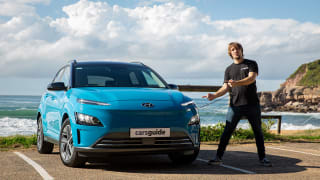Like most electric cars, the cost-of-entry for the EQA is a bit higher than its combustion counterpart. But in the premium space in which Mercedes plays, the delta between equivalent spec levels of the EQA and GLA (on which it's based) is much less than for, say, Hyundai’s Kona Electric.
The EQA 250, which is the only variant thus far available in Australia, wears a before on-roads price-tag (MSRP) of $76,800.

Pricey for a small SUV, even a premium one, but the fact it comes in at just $6900 more than the spec-equivalent GLA 250 is impressive.
Especially when you consider Hyundai’s similarly sized Kona Electric (at $66,000) commands a $28,000 price premium over its combustion equivalent. Ouch.
The EQA’s main primo rival for now is the Volvo XC40 Recharge Pure Electric ($76,800), and there’s always the threat of the sleek Tesla Model 3 Long Range ($73,400).
The latter will soon be joined by its SUV equivalent, the Model Y, which should still be priced within consideration distance when it arrives some time in 2022.
With every electric car, you’ll need to consider range in the value equation, and this electrified small SUV is pretty good here with a WLTP-certified 426km on offer.

While the Model 3 Long Range offers significantly more for less money, I’d consider the Merc to have plenty of distance between charges for most city-slickers.
There’s more good news when it comes to charging, which ups the convenience factor for the Mercedes, but we’ll talk about that in the energy consumption part of this review.
Standard equipment includes pretty much everything you can think of, fulfilling the German brand’s flashy interior promise.
There are glitzy 19-inch alloy wheels, full LED light systems all around, the brand’s signature dual 10.25-inch ‘MBUX’ digital dash and multimedia array with Apple CarPlay and Android Auto support, built-in sat nav and DAB+ digital radio.
Also included is a 10-speaker audio system, wireless phone charging bay, power adjustable front seats with heating function, ‘Artico’ synthetic leather interior trim, dual-zone climate control, and an LED ambient interior lighting package.

Our car also came packed with the ‘AMG-Line Sports Package’ ($2269) including improved seats and interior trims, as well as 20-inch alloy wheels, the ‘Vision Package’ ($2269) which includes a panoramic sunroof with surround parking cameras, black interior woodgrain trim ($231), and ‘Urban Guard Vehicle Protection Plus’ ($846) including enhanced anti-theft alarm and monitoring systems, for a grand total of $83,193 when you factor in $816 of luxury car tax (should this really apply to electric cars?).
I’d argue much of the options list is unnecessary, although I will admit the panoramic sunroof was a fitting addition, particularly as it was packaged with the handy surround parking suite.






















